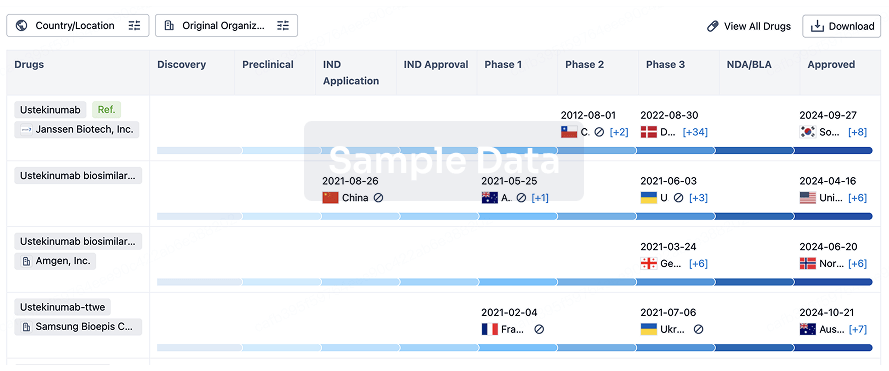Request Demo
Last update 08 May 2025
aTRX(Oblique Therapeutics)
Last update 08 May 2025
Overview
Basic Info
Drug Type Antibody |
Synonyms- |
Target- |
Action- |
Mechanism- |
Therapeutic Areas |
Active Indication |
Inactive Indication- |
Originator Organization |
Active Organization |
Inactive Organization- |
License Organization- |
Drug Highest PhasePreclinical |
First Approval Date- |
Regulation- |
Related
100 Clinical Results associated with aTRX(Oblique Therapeutics)
Login to view more data
100 Translational Medicine associated with aTRX(Oblique Therapeutics)
Login to view more data
100 Patents (Medical) associated with aTRX(Oblique Therapeutics)
Login to view more data
9
Literatures (Medical) associated with aTRX(Oblique Therapeutics)01 Mar 2024·Asian Journal of Neurosurgery
IDH1, ATRX, p53, and Ki67 Expression in Glioblastoma patients: Their Clinical and Prognostic Significance—A Prospective Study
Article
Author: Meel, Mukta ; Jindal, Arpita ; Singh, Ashok ; Kumar, Mukesh ; Mathur, Kusum
01 Jul 2023·European journal of nuclear medicine and molecular imaging
Somatostatin receptor activity assessed by 68Ga-DOTATOC PET can preoperatively predict DAXX/ATRX loss of expression in well-differentiated pancreatic neuroendocrine tumors.
Article
Author: Gianolli, Luigi ; Falconi, Massimo ; Mapelli, Paola ; Andreasi, Valentina ; Bezzi, Carolina ; Schiavo Lena, Marco ; Picchio, Maria ; Baldassi, Francesco ; De Cobelli, Francesco ; Ghezzo, Samuele ; Canevari, Carla ; Partelli, Stefano ; Muffatti, Francesca ; Magnani, Patrizia
01 Nov 2019·Current Research in Food Science
Antioxidant active packaging systems to extend the shelf life of sliced cooked ham
Article
Author: Lorenzo, José M ; Munekata, Paulo E S ; Domínguez, Rubén ; Bermúdez, Roberto ; Pateiro, Mirian ; Gagaoua, Mohammed ; Zhang, Wangang
1
News (Medical) associated with aTRX(Oblique Therapeutics)23 Feb 2023
Recent advances in cancer genomics have deepened the medical community’s understanding of the molecular alterations in brain tumours, more precisely subclassifying patients into specific diagnoses. Understanding a patient's brain tumour mutation status in the IDH1 and ATRX genes enables more informed clinical decisions and may improve patient outcomes. The IDH1 R132H and ATRX antibodies are the latest additions to Roche’s neuropathology portfolio, which contains 29 biomarkers.
Basel, 23 February 2023 - Roche (SIX: RO, ROG; OTCQX: RHHBY) announced today the launch of the IDH1 R132H (MRQ-67) Rabbit Monoclonal Primary Antibody and the ATRX Rabbit Polyclonal Antibody to identify mutation status in patients diagnosed with brain cancer.
A brain tumour is formed when there is an abnormal growth of cells in the brain. There are two main types of cells in the brain: neurons, the communicators of the nervous system and glial cells, which support and protect neurons and maintain the body’s natural state of balance. Gliomas, brain tumours that develop from glial cells, are the most prevalent type of malignant brain tumours in adults.1
Gliomas that have mutations in the IDH1 and ATRX genes are biologically distinct from tumours that do not carry these mutations. Knowing a patient’s IDH1 and ATRX mutation status enables clinicians to provide personalised care to patients based on their specific tumour classification, including a more informed prognosis, the selection of targeted therapies and inclusion in clinical trials.2
“A patient's IDH1 status helps determine eligibility for clinical trials, which offers more treatment options, and may one day lead to potential targeted therapies for people fighting brain cancer,” said Matt Sause, CEO of Roche Diagnostics.
Time is critical for patients fighting brain cancer. Patients diagnosed with glioblastoma, the most common brain cancer in adults, have an average survival rate of less than one year. Having an understanding of a glioma patient's mutation status will enable clinicians to quickly determine the optimum treatment path for that patient and help predict therapeutic outcomes.
Immunohistochemistry is recommended by all major glioma practice guidelines for determining IDH1 R132H and ATRX mutation status.3-5 When compared to sequencing, identification of IDH1 R132H mutations via immunohistochemistry has been shown to be more accurate, rapid, accessible and cost effective.6 The IDH1 assay can also detect the IDH1 R132H mutation in acute myeloid leukaemia (AML).
Roche’s IDH1 and ATRX assays are optimised and fully-automated on the BenchMark series of instruments. The two tests are now available in the US. They will likely be available in other non-CE markets later this year and in countries that accept the CE mark in 2024.
About the IDH1 R132H (MRQ-67) Rabbit Monoclonal Antibody and the ATRX Rabbit Polyclonal AntibodyRoche’s IDH1 R132H (MRQ-67) Rabbit Monoclonal Antibody can detect the IDH1 R132H mutation in adult-type gliomas and in acute myeloid leukaemia (AML). When present, IDH1 R132H is associated with a relatively favourable prognosis and is important in patient stratification for clinical trials.2 IDH1 R132H immunohistochemistry is recommended by all major glioma clinical practice guidelines as the initial IDH testing modality.3-5 Roche’s ATRX Rabbit Polyclonal Antibody detects a mutation in the ATRX gene, providing significant diagnostic and prognostic information to clinicians. ATRX testing is considered “desirable” by the World Health Organization for IDH-mutant gliomas.3
About Roche Founded in 1896 in Basel, Switzerland, as one of the first industrial manufacturers of branded medicines, Roche has grown into the world’s largest biotechnology company and the global leader in in-vitro diagnostics. The company pursues scientific excellence to discover and develop medicines and diagnostics for improving and saving the lives of people around the world. We are a pioneer in personalised healthcare and want to further transform how healthcare is delivered to have an even greater impact. To provide the best care for each person we partner with many stakeholders and combine our strengths in Diagnostics and Pharma with data insights from the clinical practice.
In recognising our endeavour to pursue a long-term perspective in all we do, Roche has been named one of the most sustainable companies in the pharmaceuticals industry by the Dow Jones Sustainability Indices for the thirteenth consecutive year. This distinction also reflects our efforts to improve access to healthcare together with local partners in every country we work.
Genentech, in the United States, is a wholly owned member of the Roche Group. Roche is the majority shareholder in Chugai Pharmaceutical, Japan.
For more information, please visit www.roche.com.
All trademarks used or mentioned in this release are protected by law.References[1] Finch, A. et al. Advances in Research of Adult Gliomas. Int J Mol Sci. 2021; 22(2):924.[2] Gritsch S, et al. Diagnostic, therapeutic, and prognostic implications of the 2021 World Health Organization classification of tumours of the central nervous system. Cancer. 2022 Jan 1;128(1):47-58.[3] WHO Classification of Tumours Editorial Board. Central nervous system tumours [Internet]. Lyon (France): International Agency for Research on Cancer; 2021. Accessed Feb 2 2022. (WHO classification of tumours series, 5th ed.; vol. 6). Available at: https://tumourclassification.iarc.who.int/chapters/45.[4] National Comprehensive Cancer Network Guidelines. Central Nervous System Cancers (Version 2.2022). https://www.nccn.org/professionals/physician_gls/pdf/cns.pdf. Accessed Oct 29 2022.[5] Weller, M. et al. EANO guidelines on the diagnosis and treatment of diffuse gliomas of adulthood. Nat Rev Clin Oncol. 2021;18,170-186.[6] IDH1/2 Mutations in Glioma: ESMO Biomarker Factsheet. European Society for Medical Oncology. Updated Nov 23 2016. Available at: https://oncologypro.esmo.org/education-library/factsheets-on-biomarkers/idh1-2-mutations-in-glioma. Accessed Jan 5 2023.
Roche Group Media RelationsPhone: +41 61 688 8888 / e-mail: media.relations@roche.com
Hans Trees, PhDPhone: +41 79 407 72 58
Nathalie AltermattPhone: +41 79 771 05 25
Karsten KleinePhone: +41 79 461 86 83
Nina MählitzPhone: +41 79 327 54 74
Dr. Barbara von SchnurbeinPhone: +41 79 699 97 44
Sileia Urech Phone: +41 79 935 81 48
Attachment
23022023_MR_IDH1_en
Clinical StudyImmunotherapy
100 Deals associated with aTRX(Oblique Therapeutics)
Login to view more data
R&D Status
10 top R&D records. to view more data
Login
| Indication | Highest Phase | Country/Location | Organization | Date |
|---|---|---|---|---|
| Triple Negative Breast Cancer | Preclinical | - | 21 Mar 2022 |
Login to view more data
Clinical Result
Clinical Result
Indication
Phase
Evaluation
View All Results
| Study | Phase | Population | Analyzed Enrollment | Group | Results | Evaluation | Publication Date |
|---|
No Data | |||||||
Login to view more data
Translational Medicine
Boost your research with our translational medicine data.
login
or

Deal
Boost your decision using our deal data.
login
or

Core Patent
Boost your research with our Core Patent data.
login
or

Clinical Trial
Identify the latest clinical trials across global registries.
login
or

Approval
Accelerate your research with the latest regulatory approval information.
login
or

Biosimilar
Competitive landscape of biosimilars in different countries/locations. Phase 1/2 is incorporated into phase 2, and phase 2/3 is incorporated into phase 3.
login
or

Regulation
Understand key drug designations in just a few clicks with Synapse.
login
or

AI Agents Built for Biopharma Breakthroughs
Accelerate discovery. Empower decisions. Transform outcomes.
Get started for free today!
Accelerate Strategic R&D decision making with Synapse, PatSnap’s AI-powered Connected Innovation Intelligence Platform Built for Life Sciences Professionals.
Start your data trial now!
Synapse data is also accessible to external entities via APIs or data packages. Empower better decisions with the latest in pharmaceutical intelligence.
Bio
Bio Sequences Search & Analysis
Sign up for free
Chemical
Chemical Structures Search & Analysis
Sign up for free
